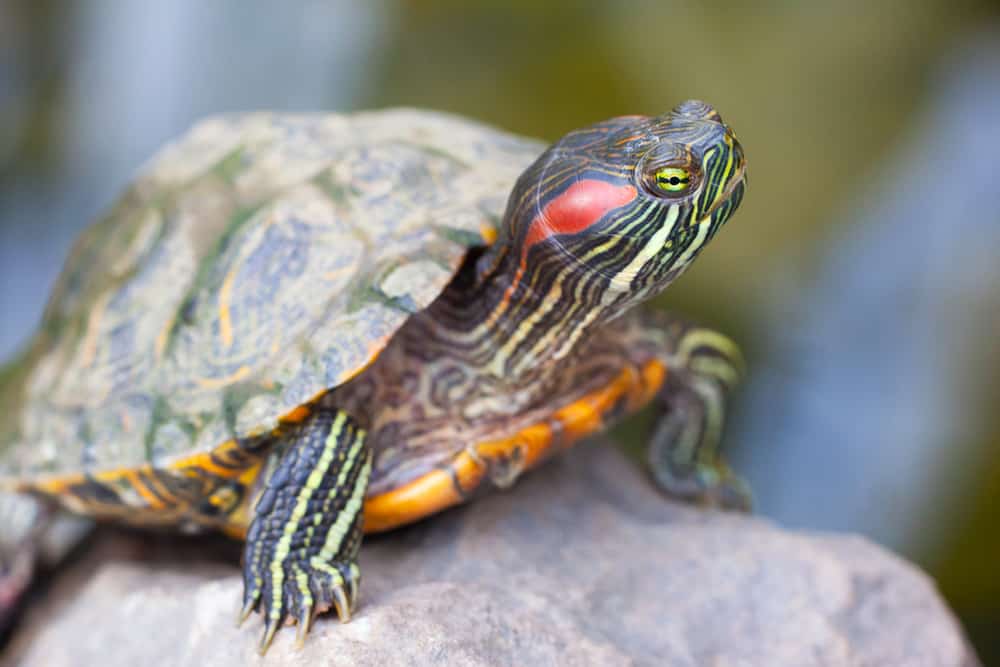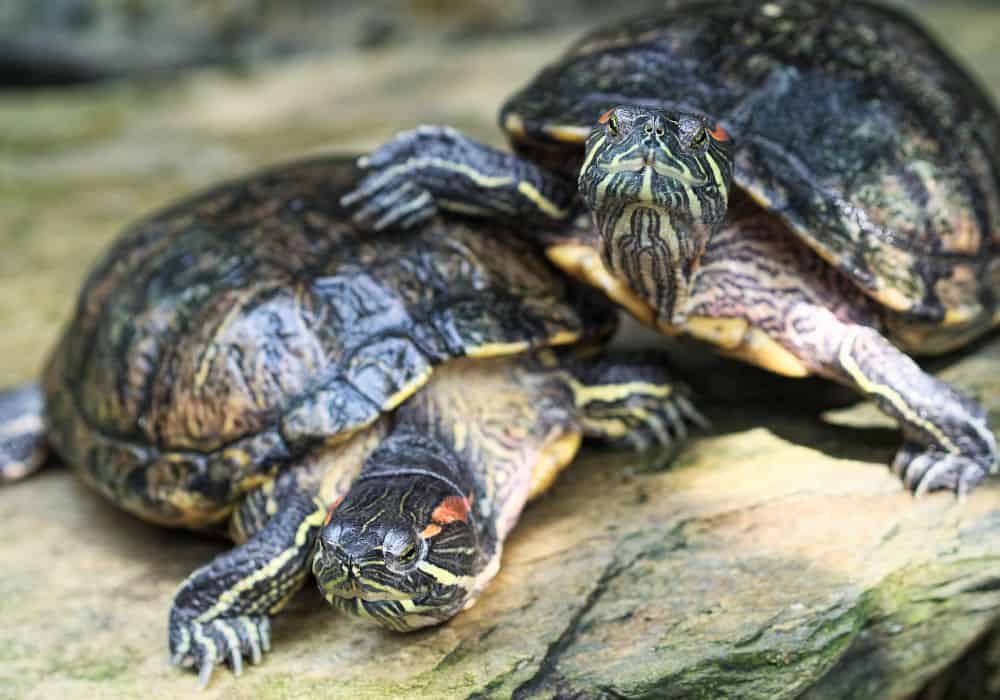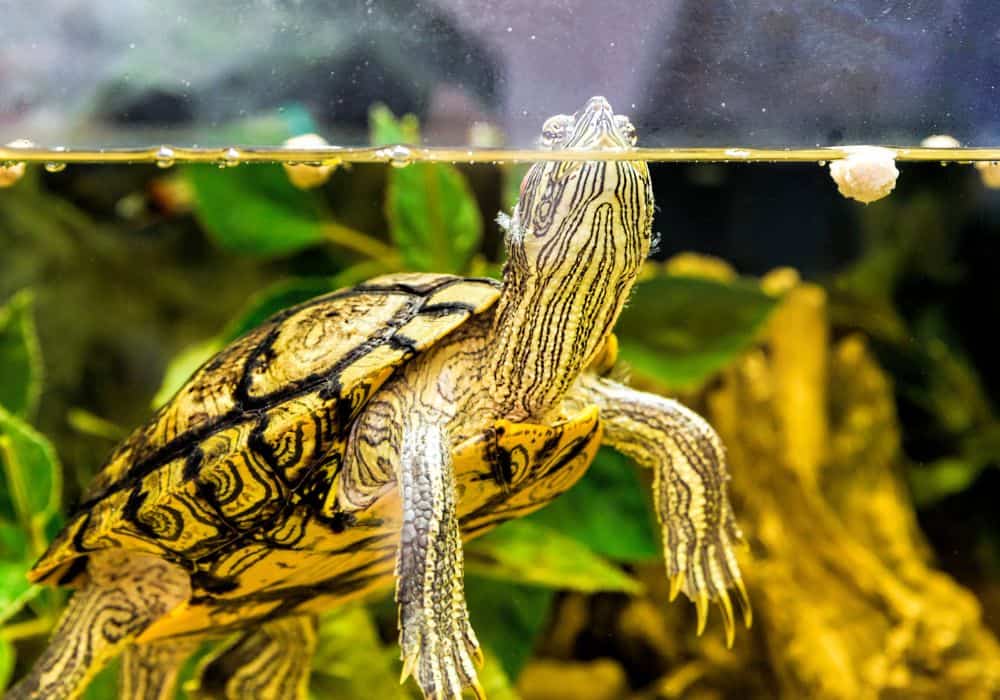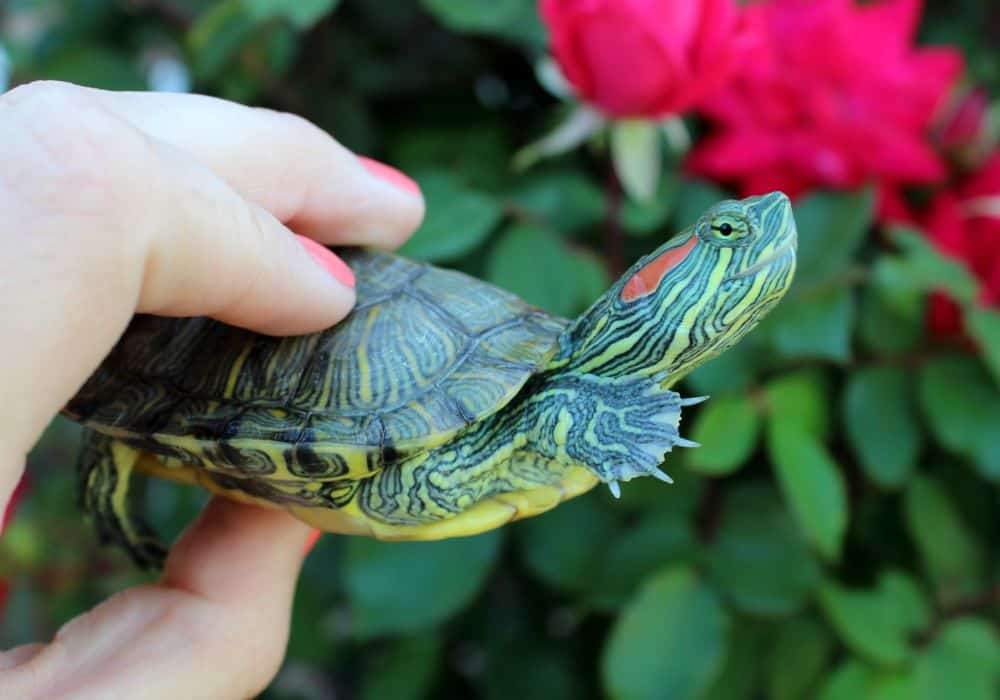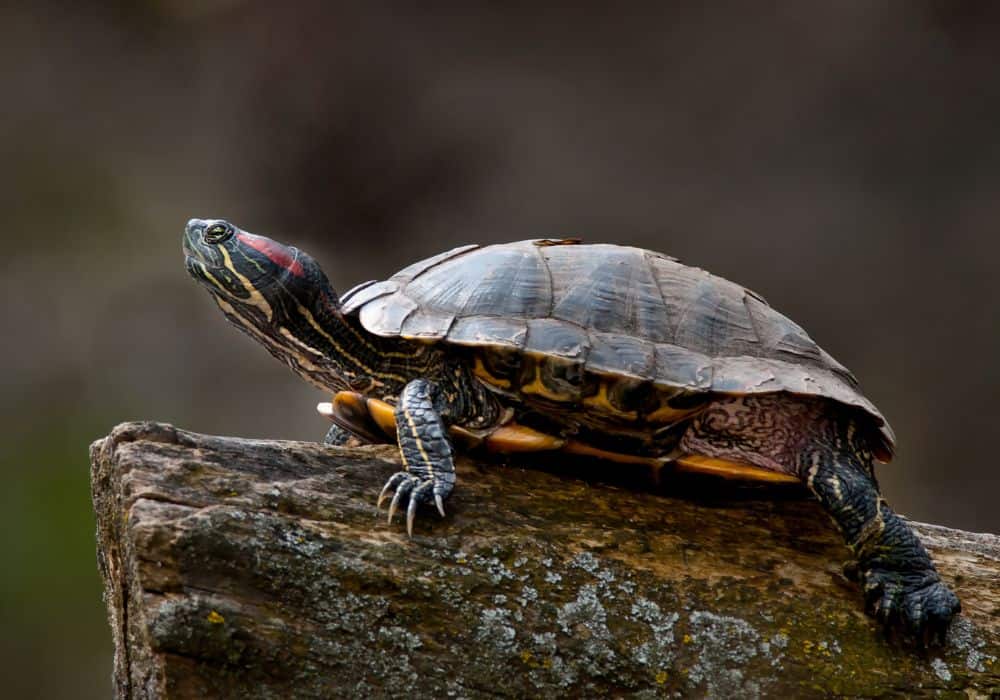Having a red-eared slider turtle as a pet can be a lot of fun. But caring for this little creature may be harder than you think. You need to provide them with a large tank with water as well as a dry area, and also frequent cleaning. Think about all the sides of red-eared slider care and the animals’ aspects before getting one as a pet, and once you decide to get one, they will be your friends for as long as 30 years.
A brief introduction to red-eared slider turtles
The red-eared slider gets its name from the red line that runs behind its eyes as well as the sliding movement it produces as it slides into the water. Chrysemys scripta elegans is the scientific name for the red-eared slider. It is an aquatic turtle that can be seen on rocks, logs, or any ground near water in the wild. Turtles are cold-blooded reptiles. They will enjoy the sun’s rays and, in the wild, will dig holes during the winter to hibernate. This adaptable pet prefers warm environments but can prosper in a large tank in your house with the proper care.
Red-eared sliders are medium-sized turtles. They have unique red patches on the sides of their heads as adults. Their carapace and skin are olive to brown, with yellow or green stripes. Females are typically larger than males, but males have longer tails.
Where do red-eared slider turtles live in nature?
The turtles originated from the United States’ Mississippi River. The red-eared slider’s natural habitat extends from Illinois to the Gulf of Mexico, and from the East Coast to Texas.
Red-eared sliders live in a wide range of freshwaters like rivers, ponds, lakes, swamps, and marshes. Man-made ecosystems such as ditches and canals can also be their home.
The turtles are now present in every continent except Antarctica. Their main method of introduction is through illegal release due to their trend as pets. Even though they are small at youth, they will become big adults with additional needs that the animal owners may not anticipate.
What do red-eared slider turtles eat in the wild?
The red-eared turtle is an omnivore species that eat almost anything that it can get. In their natural habitat, their diet consists of plants and small animals from the same ecosystem. They eat plants such as aquatic grass and algae, as well as small animals such as insects, fish, and frogs.
The diet in non-native habitats is similar. It tends to vary depending on the native wildlife of prey and plants.
Red-eared slider turtles can go months without eating. They reduce their metabolism and activity level. Because the body stays alive on deposits, an undernourished or skinny turtle may not be able to survive a lot without feeding.
Can red-eared slider turtles be kept as a pet?
If you are ready to give your full attention to their treatment, red-eared sliders make excellent pets. If you are not always at home, a turtle may be preferable to a dog or a cat. Red-eared slider turtles, on the other hand, require a lot of research and care. Warmth, clean water, and a proper diet are the three most important factors in keeping a Red-eared Slider healthy.
These turtles are pretty smart animals. They can identify their owners and their own names. Turtles, on the other hand, are not really huggable pets. They are calm, but if triggered, they can become aggressive and start biting.
Turtles adapt to new surroundings quickly, but they may hide in the first few days. But they will soon associate their owner with food and will anticipate your arrival. Turtles must be treated softly, with no sudden moves, and when you pick them up do it with both hands propping up the body and legs. If you allow older children to handle the turtle, teach them how to do it and ensure that they wash their hands thoroughly.
Tank setup requirements for keeping red-eared slider turtles
Red-eared sliders require tanks that are similar to their natural setting, warm, with water and a dry area. According to www.reptifiles.com, it’s a widespread myth that the size of a red-eared slider tank limits the turtle’s development. This isn’t true, because the size of a turtle’s enclosure has no impact on its size. So, keeping a turtle in a tiny tank won’t work, and it will just be neglected in the end.
Size
A glass or acrylic aquarium is the most common housing. A commonly accepted minimum for accommodating a turtle is 10 gallons/38 liters of water per inch of shell length. Always note that bigger is better with tanks. The red-eared slider is an active turtle and the bigger tank will be enjoyed.
Water
The health of the turtle is dependent on the quality of the water. Water has the potential to be an ideal environment for the growth of bacteria.
Before adding the water to the aquarium, it should be treated with a dechlorinating agent. If the turtle is moved for feeding, you can change the water once a week. A siphon can be used to eliminate a part of the water, typically 25-50%. While siphoning water, you can use as a vacuum cleaner to clean the area at the bottom. The entire aquarium should be drained and cleaned every 1-2 months.
Furnishing
Your turtle’s space must have a way for it to smoothly exit the water. It also needs basking areas that aren’t in the water. Aquarium gravel can be used to create a ledge for a dry land area. A basking place can be made out of cork bark, driftwood, plexiglass or a steady platform of rocks. Plastic plants aren’t the best idea, because the turtle may confuse them for food and try to eat them.
Light and heat
You can put the cage in direct sunlight if it’s not too powerful. If you have a glass or acrylic aquarium, never place it in direct sunlight as it will get too warm. Use full spectrum ultraviolet (UVA and UVB) fluorescent lighting to boost the turtle’s Vitamin D-3.
The air and water temperature in the aquarium area must be around 75 degrees Fahrenheit. An incandescent light bulb with a reflector (75 watts or less) should be placed over the cage.
You can also get a tank stand for your turtle tank for added convenience and visual appeal.
What can I feed my red-eared slider turtle?
A nutritive diet combined provides turtles with the nutritional value they require to live properly. You need to make sure that a captive’s red-eared slider’s food provides them with the same nutrient quality as in the outdoors. Www.small-pets.lovetoknow.com advises red-eared slider turtle owners on following this tip: give them 50% vegetables, 25% commercial turtle pellets, and 25% protein for an adult slider. This is the foundation for creating a healthy diet for a turtle.
In the wild, adult red-eared slider turtles eat a wide range of foods, while babies are mostly carnivorous. As pets, we can offer them a few choices:
Greens
collard greens, mustard greens, dandelion greens, kale, romaine lettuce and bok choy. You should avoid iceberg lettuce because it contains few nutrients.
Aquatic Plants: Turtles frequently consume submerged plants such as anacharis, water hyacinth, water lettuce, duckweed, azolla, and frog-bit.
Vegetable
carrots, squash, spinach and green beans.
Proteins
Shrimp, krill, waxworms, aquatic snails, mealworms, bloodworms, crickets, daphnia, earthworms and silkworms. They may need to be broken into tiny chunks for small turtles. These worms can be found in most pet stores. It is not advisable to get worms from your yard because they could include herbicides and parasites. Larger turtles can be fed bigger things such as tadpoles or feeder fish, but some (such as goldfish) are too fatty on a regular basis.
Pellet
Turtle pellets are a common food source for captive red-eared sliders.
These pellets and commercial turtle food are a healthy source of protein, vitamins, and minerals that other foods may lack. The size and age of your turtle influence your choice of pellet. Big pellets float on water so they are ideal for larger adult turtles. Small pellets that sink are perfect for smaller and younger turtles.
How often should I feed them?
In nature, turtles need to eat whenever the chance arises. They do this in order to survive, as they don’t have the privilege of choosing their meals. Turtles are known as messy eaters, so when you are about to feed them, take them out of the tank. This will reduce the amount of feces in the turtle’s water. Give the turtle 15 minutes to eat before returning it to its place. It is also simpler to track how much and how quickly your turtle eats if you feed it in a separate space.
Baby Red-Eared Sliders Feeding Schedule
The eating plan of baby red-eared sliders is 75% protein and 25% plant matter. Babies grow quickly and that’s why they require regular protein-rich feedings. Give them as much as they can eat in 15 minutes twice a day. They won’t usually overeat, so feeding them shouldn’t be too hard.
Adult Red-Eared Sliders Feeding Schedule
Compared to the youngers, adult red-eared sliders require less food. They can survive on feeding every 2-3 days. The amount of food you must give them differs, so also feed them as much as they can in 15 minutes. Some people give them smaller portions on a daily basis, and this can work as well. Remember just not to give them too much. Red-eared slider turtles have voracious appetites and can become overweight rather fast. Www.misfitanimals.com warns turtle owners about skin bulging around the legs and neck, which is a sign of overeating. If this occurs, you need to reduce the amount of food.
How to care for them?
There are a few things to look for when you bring home your red-eared slider. Learn where to get a healthy turtle and even rescue one if you can. Examine its eyes, shell, swimming style, and if it’s active. Knowing this will help you determine if you made the right choice and have a healthy pet.
Slider turtles are among the most popular pet turtles, and for a valid reason. They’re tough, adaptable, and forgiving of rookie mistakes (such as various water temperatures and pH.) They do, nevertheless, have some simple requirements that must be fulfilled in order for them to live a happy and long life with you.
To be fully prepared and provide the best care for red-eared sliders, you must first research and learn about them, as well as consider the time and financial commitment. They require proper home and daily care, ranging from feeding to simple checks or interactions.
Conclusion
Red-eared slider turtles make an amazing first pet for anyone who is willing to research and provide the necessary care. They are unique creatures with distinct personalities, so expect their attachment if you bond with them. Red-eared sliders are pets that can live for 30 years or more. While they are intriguing, they do necessitate a lifelong commitment. If you read everything, take everything into consideration and feel like this is still the pet for you, then relax and enjoy the calm nature of your next pet, the red-eared slider.
